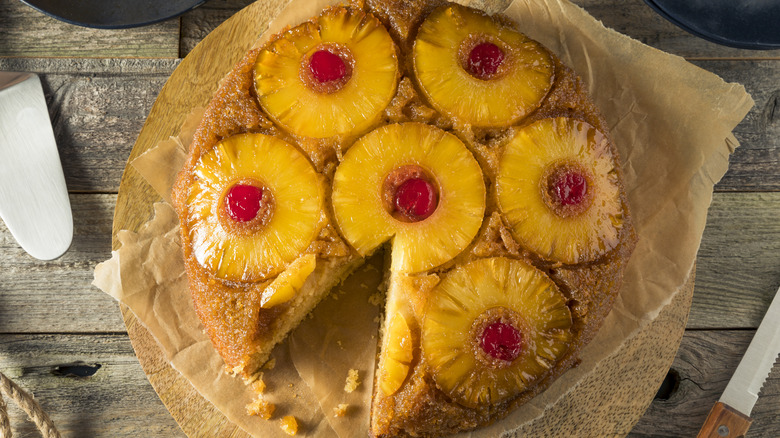Grandma's Old-School Cake Recipe That Deserves A Comeback
In our assortment of old school cakes nobody eats anymore, we shine a light on tasty vintage treats like Madeira cake and spotted dick (get your mind out of the gutter). Pineapple upside down cake also makes an appearance on our list, as this simple yet tasty treat is bursting with sweet, tropical flavors. The cake's unique construction is also a big part of its charm, as recipes require that the butter, brown sugar, and pineapples slices (with candied cherries in the center) serve as the foundation for the cake batter, which is added last before the dessert goes into the oven. Once baked, the cake is carefully flipped to become a feast for the eyes and tastebuds.
Upside down cakes were around before pineapple had its moment in the sun, and these desserts were typically called skillet cakes in a nod to how they were made. All types of fruit could be used in skillet cake recipes. For example, Tarte Tatin is a French dessert featuring caramelized apples. On the other hand, Portuguese bolo de ananás is a less sweet version of pineapple upside down cake. It's not fully clear why pineapple upside down cake fell out of favor, as tasty as it is, but its associations with '60s and '70s era desserts might be a reason why.
Dole is partially responsible for the popularity of pineapple upside down cake
Pineapples get their moniker from outdated botanical naming conventions and have held a stately reputation throughout history. The fruit is native to South America — specifically the region where Argentina, Brazil, and Paraguay are located. From there, the fruit spread to many locales all over the world. Eventually, it made its way to colder, less hospitable climates, where elaborate and expensive agricultural systems were needed to rear pineapples successfully. In the late 1800s, James Dole avoided these challenges by establishing a pineapple growing operation in Hawaii, which allowed the fruit magnate to transport pineapples to the contiguous U.S. In 1907, Dole established a cannery in Honolulu, which made pineapples even more accessible.
Fast forward to 1925, and a recipe contest held by Dole inadvertently put pineapple upside down cake on the map. The cake won top honors and was included in the official Dole cookbook, but it's claimed that 2,500 of the contest entries featured the dessert. As a result, Dole used the popular cake in its marketing campaigns, and pineapple upside down cake quickly captured the nation's attention. Though its popularity has waned a bit over the years, a dessert this indulgent definitely deserves a second chance.

